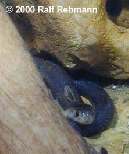|
Naja kaouthia






Namen:
Monokelkobra; Monocled Cobra, Monocellate Cibra,
Monocellate Cobra, Thailand Cobra, Monacled Cobra, Bengal Cobra;
Lokale Namen:
Mwe Haut, Ular Sendok, Ngu Hao, Ngu Hao Dam
Alte Namen:
- Naja kaouthia
- Naja tripudians var. fasciata
- Naja naja sputatrix
- Naja naja kaouthia
- Naja kaouthia kaouthia
- Naja kaouthia suphanensis
Vorkommen: Bangladesch, Myanmar (=
Burma), Kambodscha, Nordost-Indien, Laos, Nord-Malaysia, Nepal (fraglich),
Süd-China, Thailand, Süd-Vietnam.
Beschreibung: Die
Tiere erreichen eine durchschnittliche Länge von einem Meter, maximal zwei
Metern. Die Färbung ist sehr unterschiedlich. Es gibt die Schlangen in
oliv, graugrün, bräunlich, beige, rotbraun und in gelblichen Tönen. Es
existieren auch Albinos oder sehr helle Tiere. Typisches Zeichen ist ein
dunkles, breites Band am Hals und auf der Mitte des Nackens ein ovaler, dunkler
Monokel.
Toxine:
Postsynaptische Neurotoxine, unbekannte Nekrotoxine.
Anmerkungen: Die
Tiere werden in der toxinologischen Literatur oft als Naja naja siamensis (nicht
mit der echten
Naja
siamensis verwechseln!) bezeichnet. Die Tiere sind auch in der Lage
ihr Gift zu verspeien, was aber selten vorkommt.
Symptome:
Jeder Biss durch die Schlange muss als lebensbedrohlich eingeschätzt werden.
Erste Symptome nach einem Biss sind Sprachstörungen, Schluckbeschwerden und
hängende Augenlider. Neben Herzkreislaufstörungen treten fortschreitende
Lähmungen auf, die auch die Atmungsmuskulatur betreffen und dadurch zum Tod
durch Erstickung führen. Lokal können Schmerzen, Schwellungen, Blutblasen und
Absterben des Gewebes auftreten. Ptosis, Sprachstörungen,
Schluckbeschwerden, Lähmung der Augenmuskulatur, Schläfrigkeit, Lähmung der
Skelettmuskulatur, Lähmung der Atemmuskulatur, respiratorisches Versagen,
Blutdruckabfall, Erbrechen, abdominelle Schmerzen.
Fallbeschreibungen finden Sie hier:
Maßnahmen:
Hier ist die
"pressure/ immobilization-technique" anzuwenden. Bei auftretenden
Atemstörungen ist der Patient sofort zu intubieren und zu beatmen. Die weiteren
Maßnahmen erfolgen symptomatisch. Es existiert ein Antivenin. Es sollte erst
nach Rücksprache mit einer Giftnotrufzentrale eingesetzt werden.
Bei Kontakt des Giftes mit den Augen, sind diese
ausreichend zu spülen (Versorgung
der Augen).
Literatur:
Effects of a cardiotoxin from Naja naja kaouthia venom on skeletal muscle-
Involvement of calcium-induced calcium release, sodium ion currents and
phospholipases A2 and C
Phospholipase A2-interacting weak neurotoxins from venom of monocled cobra
Naja kaouthia display cell-specific cytotoxicity
Proteome and immunome of the venom of the Thai cobra, Naja kaouthia
Polyclonal antibodies against native weak toxin Naja kaouthia discriminate
native weak toxins and some other three-fingered toxins against their
denaturated forms
Weak neurotoxin from Naja kaouthia cobra venom affects haemodynamic regulation
by acting on acetylcholine receptors
Hyaluronidase inhibitors (sodium cromoglycate and sodium auro-thiomalate)
reduce the local tissue damage and prolong the survival time of mice injected
with Naja kaouthia and Calloselasma rhodostoma venoms
Neurotoxic and myotoxic actions of Naja naja kaouthia venom on skeletal muscle
in vitro
Purification and characterization of an anticoagulant phospholipase A2 from
Indian monocled cobra (Naja kaouthia) venom
Crystal structures of an acidic phospholipase A2 from the venom of Naja
Kaouthia
Inhibition of human platelet aggregation by -amino acid oxidase purified from
Naja naja kaouthia venom
Development of a polymerase chain reaction to distinguish monocellate cobra
(Naja khouthia) bites from other common Thai snake species, using both venom
extracts and bite-site swabs
Envenomation of mice by Thai Cobra (Naja kaouthia) venom- tolerable venom
concentration and exposure time
Cross-neutralization of Thai cobra (Naja kaouthia) and spitting cobra (Naja
siamensis) venoms by Thai cobra antivenom
Comparative study of venom compositions in Thai cobra (Naja kaouthia) venoms
with two variations in hood markings- monocellate form and irregular form
Antigenic cross-reactivity between Naja kaouthia and N. siamensis crude venom
Production of highly potent horse antivenom against the Thai cobra (Naja
kaouthai)
Production and characterization of monoclonal antibodies neutralizing the
postsynaptic neurotoxin 3 from Naja kaouthia venom
Experimental evaluation of ovine antisera to Thai cobra (Naja kaouthia) venom
and its α-neurotoxin
Development of α-neurotoxin antibodies in patients envenomed by the
monocellate Thai cobra (Naja kaouthia)
Development of α-neurotoxin antibodies in patients envenomed by the
monocellate Thai cobra (Naja kaouthia)
Species difference in modulation of calcium release by Naja naja kaouthia
snake venom cardiotoxin in terminal cisternae from human and equine skeletal
muscle
Effect of calcium and phosphate ions on hemolysis induced by Pyrularia thionin
and Naja naja kaouthia cardiotoxin
Binding properties of Pyrularia thionin and Naja naja kaouthia cardiotoxin to
human and animal erythrocytes and to murine P388 cells
Use of HPLC to demonstrate variation of venom toxin composition in the
Thailand cobra venoms Naja naja kaouthia and Naja naja siamensis
Factors influencing the hemolysis of human erythrocytes by cardiotoxins from
Naja naja kaouthia and Naja naja atra venoms and a phospholipase A2 with
cardiotoxin-like activities from Bungarus fasciatus venom
Primary structure and properties of toxin CM-1b from Naja naja kaouthia
(Siamese cobra) venom- Joubert, F. J.S. Afr. J. Chem.34, 128 (1981)
The complete primary structures of three cytotoxins (CM-6, CM-7 and CM-7A)
from Naja naja kaouthia (Siamese cobra) snake venom
|